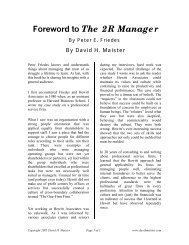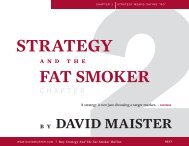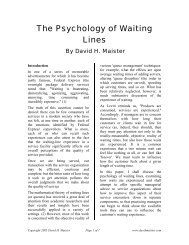Charting Your Course - David Maister
Charting Your Course - David Maister
Charting Your Course - David Maister
Create successful ePaper yourself
Turn your PDF publications into a flip-book with our unique Google optimized e-Paper software.
<strong>Charting</strong> <strong>Your</strong> <strong>Course</strong><br />
the other hand, will hire<br />
paraprofessionals and use computers to<br />
apply standard details and procedures<br />
over and over again at the most efficient<br />
cost.<br />
The senior partner in charge project<br />
manager of a strong-service firm, who is<br />
accustomed to giving individual<br />
attention to each aspect of complex<br />
projects, is rarely geared to provide the<br />
fast, efficient, routinized service desired<br />
by the strong-delivery client. Thus, the<br />
difference in staffing models makes each<br />
technology so distinct that it would be<br />
difficult to have all three models<br />
operating in top form in the same<br />
firm. The tables that accompany this<br />
article illustrate similar contrasts in<br />
strategies for all the different areas of the<br />
firm influenced by its choice of<br />
technology.<br />
Values Also Shape Management<br />
Styles<br />
The second driving force that shapes<br />
architecture organizations is the values<br />
of the professionals leading the<br />
firm. The fundamental differences in<br />
values become evident if one examines<br />
the word "practice," which is so often<br />
used by professionals to describe their<br />
organizations, in contrast to the word<br />
"business."<br />
Practice, as defined by Webster, is "the<br />
carrying on or exercise of a profession or<br />
occupation as a way of life." Business,<br />
on the other hand, is defined as a<br />
"commercial or mercantile activity<br />
customarily engaged in as a means of<br />
livelihood."<br />
When the two definitions are compared<br />
from a management perspective, what<br />
stands out is the contrast between "a way<br />
of life" and "a means of<br />
livelihood." What is becoming evident<br />
is that many architecture firms are<br />
practices first and businesses second,<br />
while others are businesses first and<br />
practices second. Therein lies a whole<br />
new perspective about what goes on in<br />
such organizations. The basic difference<br />
is their bottom line:<br />
Practice-centered professionals, who see<br />
their calling as "a way of life, " typically<br />
have as their major goal the opportunity<br />
to serve others and produce examples of<br />
the discipline they represent. Their<br />
bottom line is qualitative: How do we<br />
feel about what we are doing? How did<br />
the job come out?<br />
Business-centered professionals, who<br />
practice their calling as "a means of<br />
livelihood," more likely have as their<br />
personal objective a quantitative bottom<br />
line, which is more focused on the<br />
tangible rewards of their efforts: How<br />
did we do?<br />
As with technologies, it must be<br />
emphasized that there is nothing more<br />
noble about either choice of values. The<br />
choice is an entirely personal, largely<br />
self-serving one, derived from how<br />
individual architects view their missions<br />
in life and what they hope to get out of<br />
their lives in return for working.<br />
What is important about the distinction<br />
is the recognition that although all<br />
successful architects clearly strike a<br />
balance between practice values and<br />
business values, it makes a significant<br />
difference which of the two is<br />
primary. The choice can be expressed as<br />
a spectrum with practice-centered<br />
architecture firms at one end and<br />
business-centered firms at the other.<br />
The different positions (practicecentered<br />
versus business-centered) will<br />
lead to very different choices in<br />
significant areas of organization and<br />
Copyright 2005 <strong>David</strong> H. <strong>Maister</strong> Page 4 of 4 www.davidmaister.com











